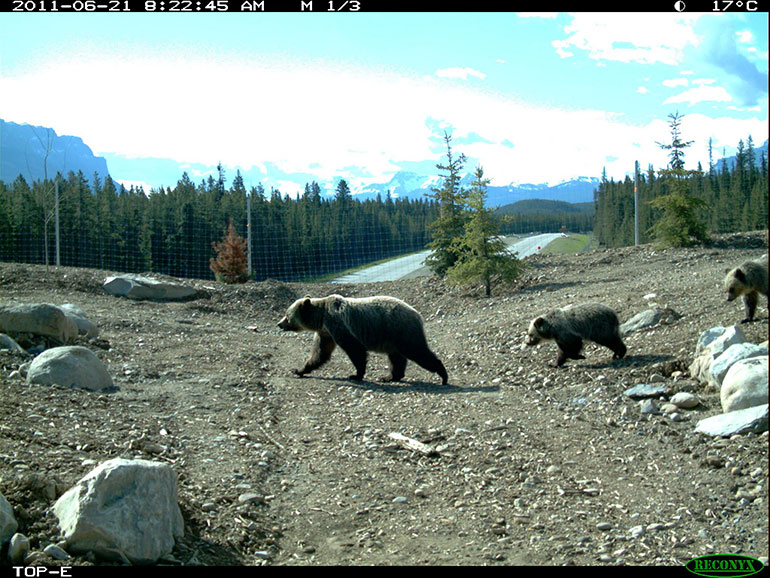
A screenshot from Banff’s Temple overpass shows a female grizzly escorting her cubs across the Trans-Canada Highway.
Design of wildlife road crossings is crucial for protecting grizzlies
Researchers have determined how female grizzly bears keep their cubs safe while crossing the Trans-Canada Highway.
Adam Ford, Canada Research Chair in Wildlife Restoration Ecology at UBC’s Okanagan campus, along with Montana State University’s Tony Clevenger, studied the travel patterns of grizzlies in Banff National Park between 1997 and 2014. In most cases, a mother bear travelling with cubs opted to use a wildlife overpass instead of a tunnel to cross the highway.
“We used data from Canada’s longest and most detailed study of road-wildlife interactions,” explains Ford, an assistant professor of biology. “We found that grizzly bear females and cubs preferred to use overpasses to cross the highway.”
During the 17-year study period, bears not travelling in these family groups used both underpasses and overpasses.
“You can’t just build a tunnel under a highway and expect to conserve bears,” says Ford. “Our work shows that the design of structures used to get bears across the road matters for reconnecting grizzly bear populations.”
The study looked at five different wildlife crossing structure designs distributed across 44 sites along a 100-km stretch of the Trans-Canada Highway. The structures are purpose-built bridges or tunnels to facilitate the safe movement of animals across roads. Tracking and motion-triggered cameras were used to monitor grizzly bear movement and Ford says all grizzly bears selected larger and more open structures like overpasses and open-span bridges, compared to tunnels and box culverts.
“Since adult females and cubs drive population growth, this research tells us that overpasses are needed to protect bears in roaded areas,” says Ford.
The study also documents the most cost-effective means to design highway mitigation. A common concern in conservation is how to allocate funding to bring the most effective gains for biodiversity. The researchers estimated the cost-effectiveness of structure designs and were surprised by the result.
“When we look at the population as a whole, there were a lot of passages made by males in box culverts, which is the cheapest type of structure to build,” explains Clevenger, stressing that a diversity of wildlife crossing structure designs along a highway is essential.
“It’s important to reduce the chances of adult males encountering cubs since the males will kill young bears,” Clevenger adds. “Creating both ‘bachelor’ and ‘family’-friendly designs will further help bear populations grow.”
This peer-reviewed study was published online this week in the Wildlife Society Bulletin.
About UBC's Okanagan campus
UBC’s Okanagan campus is an innovative hub for research and learning in the heart of British Columbia’s stunning Okanagan Valley. Ranked among the top 20 public universities in the world, UBC is home to bold thinking and discoveries that make a difference. Established in 2005, the Okanagan campus combines a globally recognized UBC education with a tight-knit and entrepreneurial community that welcomes students and faculty from around the world. For more visit ok.ubc.ca.
 Police watchdog called in
Police watchdog called in Mayor calls 'BS' on list
Mayor calls 'BS' on list U.S. authorities find bodies
U.S. authorities find bodies Premier stands by pick
Premier stands by pick Canada's most-wanted list
Canada's most-wanted list Sask. will still get rebates
Sask. will still get rebates Santos ends comeback bid
Santos ends comeback bid Douglas C-54 plane crashes
Douglas C-54 plane crashes Trump's 'eyes and ears'
Trump's 'eyes and ears' US TikTok ban sent to Biden
US TikTok ban sent to Biden Phish fans enter the Sphere
Phish fans enter the Sphere CN Rail profits fall
CN Rail profits fall  Warriors snakebitten in loss
Warriors snakebitten in loss Iginla off to Europe
Iginla off to Europe Rockets ink prospect
Rockets ink prospect Alleged Tupac killer in court
Alleged Tupac killer in court Lawsuit accuses Megan
Lawsuit accuses Megan Bam Margera’s tour axed
Bam Margera’s tour axed


